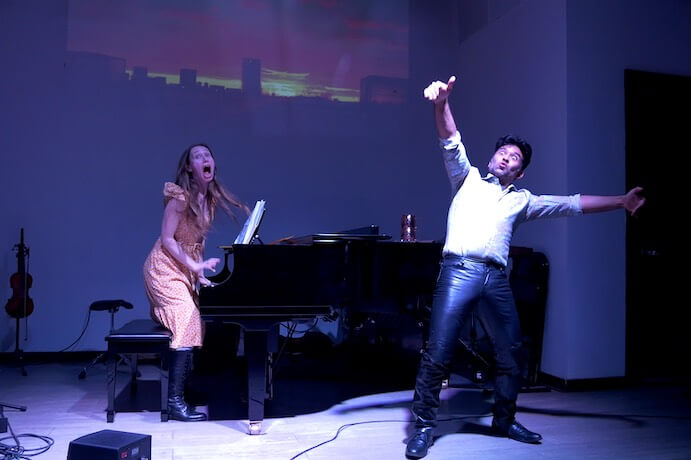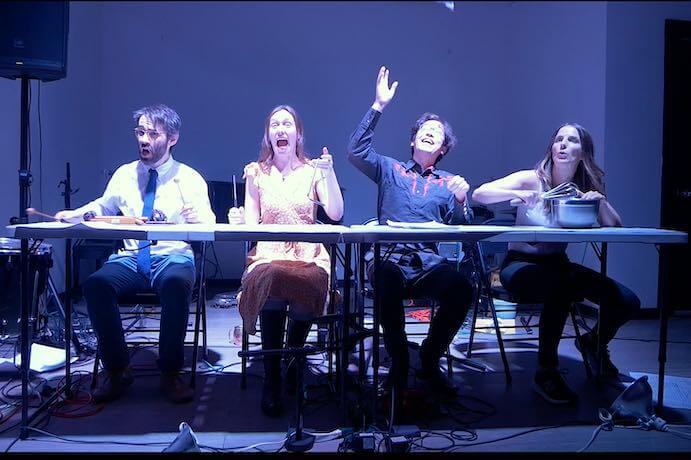On December 18, 2019, enthusiasts of the playful, theatrical, and uncannily poignant thingNY (Jeffrey Young, Dave Ruder, Erin Rogers, Paul Pinto, Andrew Livingston, and Gelsey Bell) took refuge from the cold and filled the benches at Areté, a hip and glossy gallery/performance space tucked into the rapidly developing Greenpoint, Brooklyn.
The pre-concert space was bustling and lively. Pinto stood at the thingNY merch table near the entrance, feverishly turning out programs on an old-school typewriter with a percussive tapping. As I took my seat with a personalized program full of delightful misspellings, my eyes were drawn to a text document projected above the stage. The document was being live-edited by members of the audience, who accessed it from their phones via a URL on the document header. There were some amusing notes about pizza, comments about the degree of seriousness of the music to come, and some personalized messages for friends—but the best moment came when we collectively realized that someone had deleted a number from the URL, effectively locking everyone else out. A bit of chaos erupted as members of thingNY and audience members attempted to sort it out.
In hindsight, the understated pre-concert space created an immersive introduction to the main draw of the program: a visual and sonic exploration of language and communication. Works by Jessie Marino, Sam Scranton, Paul Pinto, Jennifer Walshe, and Robert Ashley (arranged by Pinto) approached the topic with equal parts nuance and kitsch, with enough variety to keep the nearly two-hour program fresh and engaging.

thingNY–Photo by Brian McCorkle
The evening opened with the U.S. premiere of Jessie Marino’s The Whale is a Capital Fish (2016). This work is a sensory playground presented almost as a series of vignettes on language. It begins with narrators (live and recorded) introducing themselves, but any sense of identity is soon obfuscated by the performers who take turns madly lip-syncing along like feral puppets. Members of thingNY sat at a table covered with objects, costume pieces, and lights—props and instruments used to give the audience fractured glimpses into strange spaces. The end of the piece featured a mesmerizing, buzzing Morse code chorus and a projected graphic of a swimming whale that gradually blurred into obscurity.
Sam Scranton’s Baleen (2017) was a musical highlight of the evening. Livingston, Bell, Ruder, and Rogers (voices) sat in chairs at the front of the stage, facing the audience and holding vases. The piece began with gentle humming and vowel sounds from all four performers that grew and subsided at different times. As the piece grew busier, the events, pitches, and vowels began to overlap in surprising ways. White noise consonant sounds later joined the texture, creating murky and indistinct implications of words. The piece ended with bits of text spoken by the performers into the vases, who shifted the timbre and clarity of their text by turning their vases. A work as free as Baleen requires performers who are deeply invested in creating something special, and thingNY rose to the occasion, creating a rich and sensitive performance.

Gelsey Bell and Paul Pinto–Photo by Brian McCorkle
Pieces like Paul Pinto’s mini_007: Music for a Recession (2015)—performed by Ruder, Bell, Young, and Rogers—and Jennifer Walshe’s Language Ruins Everything (2013)—performed by Pinto (countertenor) and Bell (piano)—demand a solid stage presence, and thingNY boldly commanded the space. Pinto’s piece features a cast of quirky characters who alternatively play small percussion (a triangle, a mixing bowl and whisk, a stack of papers) and emphatically repeat lines of dialogue, almost like mantras, all over a constant drone. Walshe’s work is chock full of user-interface references, ocean imagery, snipping sounds from a squeaky pair of scissors, tunnels, and a volunteer chorus reading singular words as they flash across a screen. In typical Walshe fashion, the odd assortment of elements somehow adds up to something greater, a multi-sensory narrative that is made compelling by the total dedication of its storytellers.
The program ended with the U.S. premiere of Robert Ashley’s Tap Dancing in the Sand (2004) arranged by Pinto for thingNY. From the piano, Pinto played spiraling, sustained seventh chords with support from Bell’s smooth vocalizing and interjections from Young (violin), Rogers (saxophone), Livingston (cello) and Ruder (guitar). The music conveyed a nostalgic, dreamlike quality over which Pinto contemplated great orators with a cozy narrative style that evoked the late Fred Rogers.

thingNY–Photo by Brian McCorkle
Halfway through the piece, the narration ceased and Bell moved to sit at a typewriter on a table in the center of the ensemble, where she began to type. She appeared to be typing the narration, once again shadowed by the ensemble as Pinto’s narration was similarly shadowed before. However, without the spoken word clouding the air, the contours in the phrases, the percussive motives, and the push and pull of the typed text became more apparent. In this contemplative space, I was struck with two thoughts. First, words are noisy—they fill the mind with sound-images, associations, and ideas. Second, oration is inherently musical—contour, motives, and flow are all qualities beneath the surface of text. “Hello. My Name Is…” is a huge program, with a lot to say, and I appreciated some time at the end of it all to just mull it over.
Perhaps more than any other New York ensemble, thingNY has cultivated a sense of joyful experimentalism and freedom. They show us that impactful and thought-provoking art can be both serious and silly, and that far from ruining everything, language is central to the creation and dissemination of art.





















